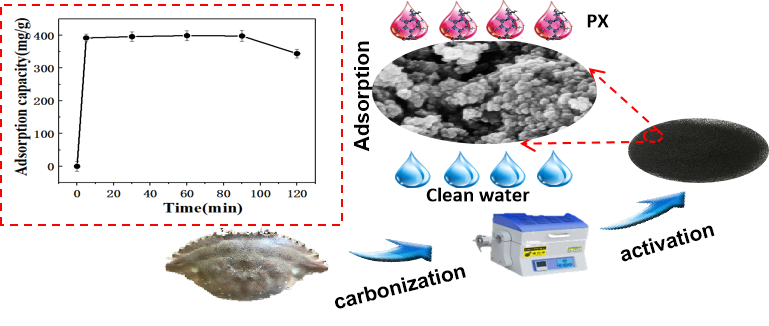 Open Access
Open Access
ARTICLE
Highly Efficient Adsorption of P-Xylene from Aqueous Solutions by Hierarchical Nanoporous Biochar Derived from Crab Shell
1
College of Food and Medical, Zhejiang Ocean University, Zhoushan, 316022, China
2
National-Local Joint Engineering Laboratory of Harbor Oil & Gas Storage & Transportation Technology, School of Petrochemical
Engineering & Environment, Zhejiang Ocean University, Zhoushan, 316022, China
3
Donghai Science and Technology College, Zhejiang Ocean University, Zhoushan, 316000, China
4
Institute of Innovation & Application, Zhejiang Ocean University, Zhoushan, 316022, China
5
College of Naval Architecture and Mechanical-Electrical Engineering, Zhejiang Ocean University, Zhoushan, 316022, China
6
College of Petrochemical and Energy Engineering, Zhejiang Ocean University, Zhoushan, 316022, China
* Corresponding Author: Lili Ji. Email:
(This article belongs to the Special Issue: Renewable Material from Agricultural Waste and By-Product and Its Applications)
Journal of Renewable Materials 2021, 9(10), 1741-1755. https://doi.org/10.32604/jrm.2021.015924
Received 24 January 2021; Accepted 16 March 2021; Issue published 12 May 2021
Abstract
The global consumption of p-xylene (PX) for the production of polymers has raised serious concerns about its impact on the environment. As various reports have shown the risks that PX could pose to human health, research into cost-effective remedial methods to remove PX from the environment has gained attraction. In this work, a hierarchical porous crab shell biochar (KCS) was synthesized, characterized, and evaluated for its effi- ciency to remove PX from aqueous solution. The characterizations of KCS, including the porous structure, surface functional group, phase structure, and surface morphology, were discussed by N2 adsorption-desorption, FTIR, XRD, and SEM. Batch adsorption experiments showed that the maximum adsorption capacity of PX on KCS was 393 mg/g within 5 min, larger than most biological/biomass materials, mainly due to the higher specific surface area of 2046 m2 /g, and abundant lipophilic functional groups. Subsequent adsorption kinetics study indicated a pseudo-second-order model which implied that the adsorption of PX was due to chemisorption. Thermodynamic parameters showed that the values of ΔH° and ΔG° were both negative, indicating that the PX adsorption process on KCS was spontaneous and exothermic. The performance of KCS in delivering a cost-effective, fast, and efficient solution for the removal of PX from aqueous solution would greatly benefit current environmental remediation efforts.Graphic Abstract

Keywords
Cite This Article
Citations
 Copyright © 2021 The Author(s). Published by Tech Science Press.
Copyright © 2021 The Author(s). Published by Tech Science Press.This work is licensed under a Creative Commons Attribution 4.0 International License , which permits unrestricted use, distribution, and reproduction in any medium, provided the original work is properly cited.


 Submit a Paper
Submit a Paper Propose a Special lssue
Propose a Special lssue View Full Text
View Full Text Download PDF
Download PDF

 Downloads
Downloads
 Citation Tools
Citation Tools